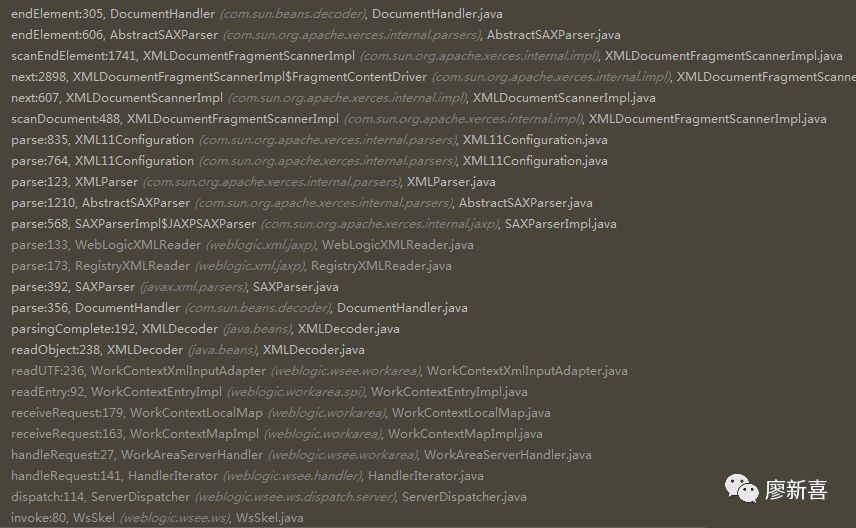
背景
这个漏洞最先由某厂商报给某银行,某银行再将该信息报给CNVD,后CNVD通告:国家信息安全漏洞共享平台(CNVD)收录了由中国民生银行股份有限公司报送的Oracle WebLogic wls9-async反序列化远程命令执行漏洞(CNVD-C-2019-48814),详情见链接:cnvd对于该漏洞,Oracle官方也破例了一回,提前发了补丁,但是这个补丁只是针对10.3.6系列的,对于12版本系列还未披露补丁。所以还是请各位谨慎对待,勒索大军跃跃欲试。
分析
某天接到工程线同事反馈的时候,说wls9-async存在远程代码执行漏洞,可能跟xmldecoder相关,因为一年前分析过该漏洞,详情[ Weblogic XMLDecoder RCE分析]( http://xxlegend.com/2017/12/23/Weblogic%20XMLDecoder%20RCE%E5%88%86%E6%9E%90/):当时第一直觉判断不应该是这个地方再出问题,查了一下相关接口,怀疑是SOAPInvokeState.getClonedSOAPMessage 的问题,后来进一步分析把这个地方排除了。一天后另一个同事给了一个非常模糊的poc,也看不到利用链。隐隐约约看到class,void,这就确定了是xmldecoder的问题,于是聚焦于xmldecoder的补丁。仔细一对比WorkContextXmlInputAdapter的validate接口,还真是能被绕过。
private void validate(InputStream is) {
WebLogicSAXParserFactory factory = new WebLogicSAXParserFactory();
try {
SAXParser parser = factory.newSAXParser();
parser.parse(is, new DefaultHandler() {
private int overallarraylength = 0;
public void startElement(String uri, String localName, String qName, Attributes attributes) throws SAXException {
if(qName.equalsIgnoreCase("object")) {
throw new IllegalStateException("Invalid element qName:object");
} else if(qName.equalsIgnoreCase("new")) {
throw new IllegalStateException("Invalid element qName:new");
} else if(qName.equalsIgnoreCase("method")) {
throw new IllegalStateException("Invalid element qName:method");
} else {
if(qName.equalsIgnoreCase("void")) {
for(int attClass = 0; attClass < attributes.getLength(); ++attClass) {
if(!"index".equalsIgnoreCase(attributes.getQName(attClass))) {
throw new IllegalStateException("Invalid attribute for element void:" + attributes.getQName(attClass));
}
}
}
if(qName.equalsIgnoreCase("array")) {
String var9 = attributes.getValue("class");
if(var9 != null && !var9.equalsIgnoreCase("byte")) {
throw new IllegalStateException("The value of class attribute is not valid for array element.");
}
核心问题在判断void标签和array标签的时候不是遇到这两个标签就抛出异常,而是做了一个for循环遍历,当属性为空的就不会进这个遍历循环,也就不会抛出异常,当然就能直接绕过。像网上一大堆使用类似 <voidclass="xxx">的假poc,假分析文章的时候,就感觉安全圈还真是个娱乐圈。此处笑脸。虽然能过了这个验证环节,但还是需要结合xml的知识来完成完整利用,比如父类,比如Soap定义等等。这也就是有些开发人员更容易构造出绕过的PoC。
知道了漏洞点,构造出PoC还是有挺多拦路虎的,我这里简单列列。
前置知识
使用 -Dweblogic.webservice.verbose=*-Dweblogic.wsee.verbose=*第一步打开调试开关。
weblogic 处理SOAP的方式:
有了这个SOAP请求处理框架图和日志,在发送测试请求的时候就能看出整个处理流程。部分日志如下:
| <WSEE>/_async/AsyncResponseService |
--------------------------------------
<WSEE:23>Created<SoapMessageContext.<init>:48>
<WSEE:23>Processing MessageContextInitHandler... <HandlerIterator.handleRequest:131>
<WSEE:23>Processing ConnectionHandler... <HandlerIterator.handleRequest:131>
** S T A R T R E Q U E S T **
<WSEE:23>HTTP REQUEST
POST /_async/AsyncResponseService
............................
<WSEE:23> from Header, got serverName='AdminServer'<ForwardingHandler.handleRequest:321>
<WSEE:23>from LocalServerIdentity.getIdentity() got serverName='AdminServer'<ForwardingHandler.handleRequest:338>
<WSEE:23>Processing SoapFaultHandler... <HandlerIterator.handleRequest:131>
<WSEE:23>Processing AsyncResponseWsrmWsscHandler... <HandlerIterator.handleRequest:131>
<WSEE:23>AsyncResponseWsrmWsscHandler.handleRequest<AsyncResponseWsrmWsscHandler.handleRequest:82>
<WSEE:23>Processing InterceptionHandler... <HandlerIterator.handleRequest:131>
<WSEE:23>Processing VersionRedirectHandler... <HandlerIterator.handleRequest:131>
...................
从上述日志就可以看出,所有的请求都会经过webservice注册的21个Handler来处理,我们把断点下在HandlerIterator.handleRequest,就能截取每一个handler。这种通用的责任链模式在web容器中还是很普遍的。具体的handler如下
过程分析
第一步,针对于这个_async入口,我们把重点放在AsyncResponseHandler上,通过其handleRequest的代码
public boolean handleRequest(MessageContext var1) {
if (var1 == null) { return true; }
else if (!(var1 instanceof SOAPMessageContext)) { return true; }
else { if (verbose) { Verbose.log("AsyncResponseHandler.handleRequest"); }
String var2 = (String)var1.getProperty("weblogic.wsee.addressing.RelatesTo"); if (var2 == null) {
return false; } else {
可以看出来必须设置RelatesTo属性,不然就直接返回了,不会进入后面反序列化的流程了。 根据 soap ws.addressing的定义ws -address,其格式为
<wsa:MessageID> xs:anyURI </wsa:MessageID>
<wsa:RelatesTo RelationshipType="..."?>xs:anyURI</wsa:RelatesTo>
<wsa:To>xs:anyURI</wsa:To>
<wsa:Action>xs:anyURI</wsa:Action>
<wsa:From>endpoint-reference</wsa:From>
<wsa:ReplyTo>endpoint-reference</wsa:ReplyTo>
<wsa:FaultTo>endpoint-reference</wsa:FaultTo>
所以poc中的第一步就是要加上ws-address的相关字段。
第二步就是在处理这个xml的过程中,必须删除多余的空格和换行,这是由于xmldecoder处理string标签的差异导致的。根据[StringElementHandler]( http://www.docjar.com/docs/api/com/sun/beans/decoder/StringElementHandler.html)的提示,可以看到
<string>description</string>is equivalent to {@code "description"} in Java code. The value of inner element is calculated before adding to the string using String#valueOf(Object) . Note that all characters are used including whitespaces (' ', '\t', '\n', '\r'). So the value of the element
<string><true></string> is not equal to the value of the element
<string>
<true>
</string>
也就是说紧凑和不紧凑是有本质区别的。不紧凑的话获取的内容是带换行和空格,这是我当时调试的时候死活找不到类的原因,坑了我不少时间。
第三步,过了前面那个坑就是找相应的payload去执行了,我给oracle提交了 com.bea.core.repackaged.springframework.context.support.FileSystemXmlApplicationContext,无视jdk版本限制,目前公开的还有 oracle.toplink.internal.sessions.UnitOfWorkChangeSet,这个类就是利用二次反序列化,二次反序列找的对象可包括
org.springframework.transaction.support.AbstractPlatformTransactionManager
,详情可见我以前的 [分析文档](
http://xxlegend.com/2018/10/23/Weblogic%20CVE-2018-3191%E5%88%86%E6%9E%90/),二次反序列还可以包括jdk7u21,rmi等等gadget,其实第一层的入口也还有挺多类,鉴于这个漏洞的严重性和急迫性,这里不做详细阐述,所以在添加规则的时候一定不能依据利用类来添加规则,说不定明天就被绕过了。下面在ProcessBuilder上下一个断点,调用栈如下:
这个漏洞以前跟过,这里就不再详细阐述。详细跟踪过程参考以前的[分析文档]( http://xxlegend.com/2017/12/23/Weblogic%20XMLDecoder%20RCE%E5%88%86%E6%9E%90/)
修复方式
新的补丁将class加入了黑名单
} else if (qName.equalsIgnoreCase("class")) {
throw new IllegalStateException("Invalid element qName:class");
这种方式对于漏洞研究人员来说还是挺好玩的。 详细的补丁如下:
private void validate(InputStream is) {
WebLogicSAXParserFactory factory = new WebLogicSAXParserFactory();
try {
SAXParser parser = factory.newSAXParser();
parser.parse(is, new DefaultHandler() {
private int overallarraylength = 0;
public void startElement(String uri, String localName, String qName, Attributes attributes) throws SAXException {
if (qName.equalsIgnoreCase("object")) {
throw new IllegalStateException("Invalid element qName:object");
} else if (qName.equalsIgnoreCase("class")) {
throw new IllegalStateException("Invalid element qName:class");
} else if (qName.equalsIgnoreCase("new")) {
throw new IllegalStateException("Invalid element qName:new");
} else if (qName.equalsIgnoreCase("method")) {
throw new IllegalStateException("Invalid element qName:method");
} else {
if (qName.equalsIgnoreCase("void")) {
for(int i = 0; i < attributes.getLength(); ++i) {
if (!"index".equalsIgnoreCase(attributes.getQName(i))) {
throw new IllegalStateException("Invalid attribute for element void:" + attributes.getQName(i));
}
}
}
if (qName.equalsIgnoreCase("array")) {
String attClass = attributes.getValue("class");
if (attClass != null && !attClass.equalsIgnoreCase("byte")) {
throw new IllegalStateException("The value of class attribute is not valid for array element.");
}
String lengthString = attributes.getValue("length");
if (lengthString != null) {
try {
int length = Integer.valueOf(lengthString);
if (length >= WorkContextXmlInputAdapter.MAXARRAYLENGTH) {
throw new IllegalStateException("Exceed array length limitation");
}
this.overallarraylength += length;
if (this.overallarraylength >= WorkContextXmlInputAdapter.OVERALLMAXARRAYLENGTH) {
throw new IllegalStateException("Exceed over all array limitation.");
}
} catch (NumberFormatException var8) {
如有侵权请联系:admin#unsafe.sh